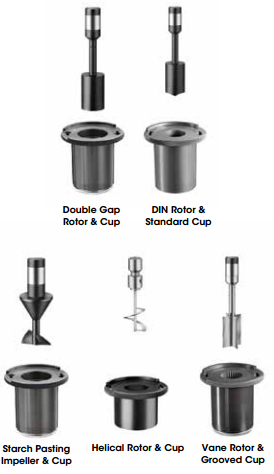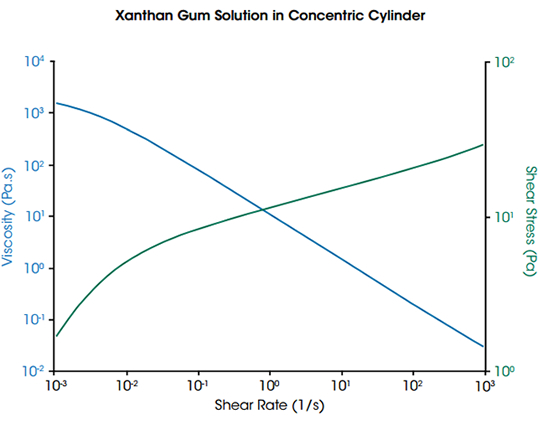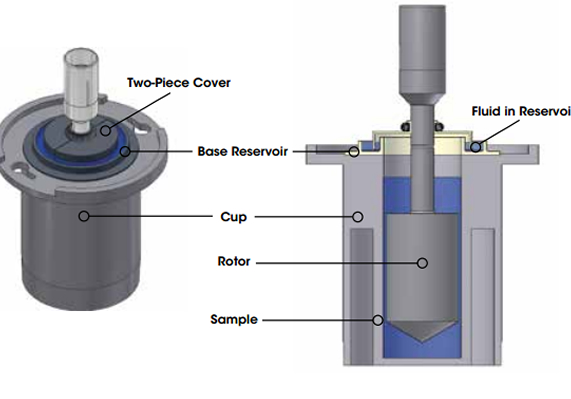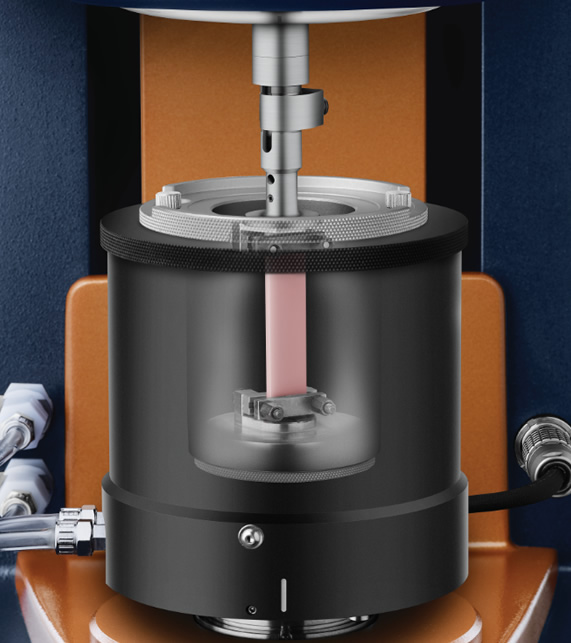Combines the convenience of Smart Swap™ and Peltier heating technology with a wide variety of cup and rotor geometries.
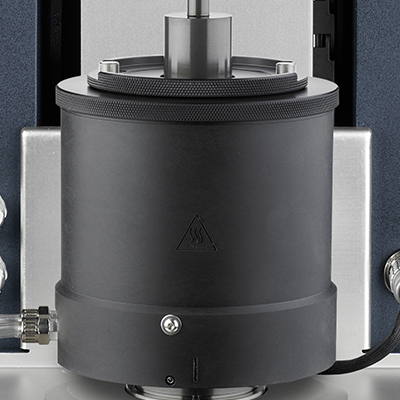
Peltier Concentric Cylinder Temperature System
The Peltier Concentric Cylinder Temperature System combines the convenience of Smart Swap™ and Peltier heating technology with a wide variety of cup and rotor geometries. Concentric Cylinder geometries are commonly used for testing low viscosity fluids, dispersions or any liquids that are pourable into a cup. Examples of materials suitable for Concentric Cylinder include low concentration polymer solutions; solvents; oils; drilling mud; paint; varnish; inkjet ink; ceramic slurries; pharmaceutical suspensions and cough medicine and baby formula; foams; food products such as juices, thickeners; dairy products including milk and sour cream; salad dressings, and pasta sauce.
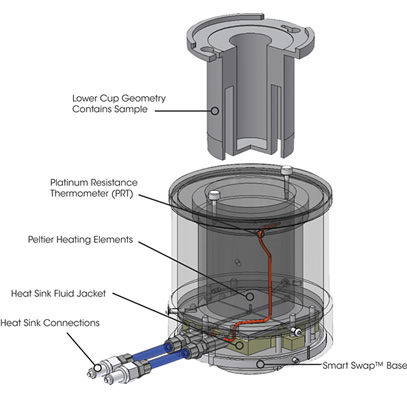 Technology
Technology
The Peltier Concentric Cylinder system offers a temperature range of -20 °C to 150 °C, with a maximum heating rate up to 13 °C/min. Four Peltier heating elements are placed in intimate contact with a lower cup geometry held in place by an insulated jacket. The unique patented design(1) of the lower geometry provides fast and efficient heat transfer up the walls of the cup. A platinum resistance thermometer (PRT) is placed close to the top of the cup ensuring accurate temperature measurement and control. The maximum controllable heating rate will depend on heat sink fluid temperature, circulator flow rate and cooling/heating capacity, and viscosity of heat sink fluid. (1) U.S. Patent # 6,588,254
The standard Peltier Concentric Cylinder geometries include a cup radius of 15 mm, configured with either a Recessed End or DIN Rotor. Both rotors have a radius of 14 mm and height of 42 mm. The double gap concentric cylinder has an additional shearing surface over single gap providing lower stress and higher sensitivity for extremely low viscosity solutions.
Special Cups and Rotors
Specialty geometries include various vanes, helical, and starch pasting impeller rotors, as well as large diameter and grooved cups. These special concentric cylinder geometries are very valuable for characterizing dispersions with limited stability, preventing error from slip at the material/geometry interface, and for bulk materials with larger particulates. Vane geometries are available in both a 14 mm and 7.5 mm radius. The large diameter cup has a radius of 22 mm. The helical and impeller rotor and cup keep a sample mixed or particles suspended during shearing.
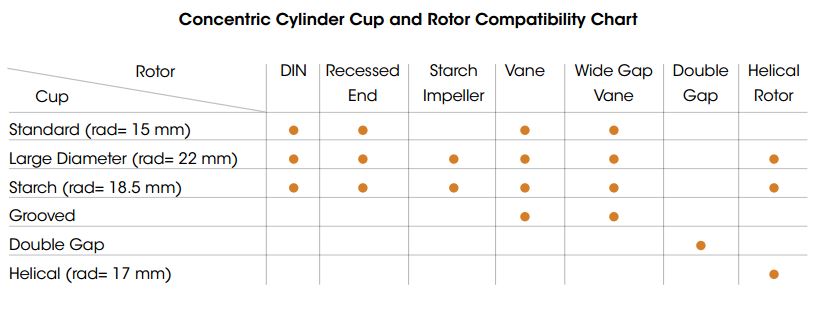
Features and Benefits
- Smart Swap™ technology
- Wide temperature range: -20 ˚C to 150 ˚C
- Peltier temperature control for fast heating and cooling
- Popular DIN standard, Recessed End and Double Gap Options
- Geometries available in Stainless Steel and Hard-Anodized Aluminum
- Wide variety of cup diameters • Impeller and Vane geometries for preventing settling and slipping, and handling of large particles
- Torsion Immersion
- Special geometries available upon request
Generic Container Holder
Generic Container Holder
The Generic Container Holder is a Smart Swap™ option that can hold any container with an outer diameter of up to 80 mm for characterizing materials with rotors. This allows for quick off-the-shelf evaluation of materials, such as paints and varnishes, creams, pasta sauce, etc., without creating large shearing from sample loading. It also is an excellent platform for beakers or jacketed beakers.
Flow Curve on Xanthan Gum
Flow Curve on Xanthan Gum
Concentric cylinder geometries are useful for gathering viscosity flow curve information over a wide range of shear rates. An example is shown in the figure for a xanthan gum solution. Five decades of viscosity are easily obtained over six decades of shear rate. This system is also a powerful alternative to parallel plate or cone and plate geometries for materials with limited stability or prone to edge failure or rapid solvent evaporation.
Concentric Cylinder Solvent Trap Cover
Concentric Cylinder Solvent Trap Cover
A Solvent Trap is available for the Peltier Concentric Cylinder. It includes a base reservoir and a two-piece cover that is mounted to the shaft of the rotor. The Solvent Trap provides a vapor barrier to seal the environment inside the cup and prevents solvent evaporation.
Characterization of Foam with Vane Rotor
Characterization of Foam with Vane Rotor
The figures below show an example of the time and frequency dependent response of a foam shaving cream characterized using a standard cup and vane geometry. The structure of shaving foam has a limited lifetime, or limited stability. The vane geometry minimizes shearing stress that occurs during loading in the gap with standard rotor, keeping the delicate foam structure intact for testing. A wide range of structural information can be captured very quickly using multiwave characterization on the DHR. The figure to the left shows a decay in storage modulus G’ as the structure of the foam breaks down with increasing time. Using the multiwave, the data are simultaneously collected over a wide range of frequencies. The data can be plotted as frequency sweeps at increasing time, as shown on the right. The results show the time dependent viscoelastic response of the shaving foam.
Torsion Immersion Cell
Torsion Immersion Cell
The Torsion Immersion Cell allows rectangular bar-shaped samples to be clamped and characterized while immersed in a temperature controlled fluid. The resulting change in mechanical properties, caused by swelling or plasticizing, can be analyzed in oscillatory experiments. This option provides a way to better understand materials under real-world conditions, such as body implants in saline or rubber seals in contact with oils and solvents.
Rheology of Pasta During Cooking
Rheology of Pasta During Cooking
The Torsion Immersion Cell can be used for various food applications such as cooking of pasta. In this example, a piece of fettuccini pasta was tested using an oscillatory time sweep test at a frequency of 6.28 rad/s and temperature of 22 °C. Data were collected on the dry sample for 2.5 min to establish a baseline storage modulus G’. Water was added after 2.5 min and the effect of the moisture is seen immediately as a decrease in the G’. At 5 min. G’ was monitored as temperature was ramped to 95 °C and held isothermally. As the pasta cooks the modulus drops about three decades and then levels out when cooking is complete.
DHR Building Materials Cell
DHR Building Materials Cell
The Building Materials Cell is a specially designed, abrasion-resistant and durable concentric cylinder cup and rotor for testing samples with large particles such as concrete slurries and mixes. The paddle type rotor, slotted cage, and the large diameter cup promote adequate sample mixing while preventing sample slip at both the cup and rotor surfaces. The removable slotted cage permits easy sample cleaning after the test while the concentric cylinder Peltier jacket provides accurate temperature control. Together with the existing array of specialty rotors and cups, the new Building Materials Cell provides the ultimate flexibility for testing a diverse range of samples with large particles including construction materials and food products.
The data below follows the structural recovery of a concrete mixture tested at 25 °C using the Building Materials Cell. The concrete sample was initially subject to large deformation to mimic processing conditions encountered during pumping. A subsequent small strain fast oscillation test simulated the development of the sample’s moduli following flow cessation. The results reveal a rapid increase in the material’s storage modulus within 10 minutes, before ultimately reaching a plateau value.
- Description
-
Peltier Concentric Cylinder Temperature System
The Peltier Concentric Cylinder Temperature System combines the convenience of Smart Swap™ and Peltier heating technology with a wide variety of cup and rotor geometries. Concentric Cylinder geometries are commonly used for testing low viscosity fluids, dispersions or any liquids that are pourable into a cup. Examples of materials suitable for Concentric Cylinder include low concentration polymer solutions; solvents; oils; drilling mud; paint; varnish; inkjet ink; ceramic slurries; pharmaceutical suspensions and cough medicine and baby formula; foams; food products such as juices, thickeners; dairy products including milk and sour cream; salad dressings, and pasta sauce.
- Technology
-
 Technology
TechnologyThe Peltier Concentric Cylinder system offers a temperature range of -20 °C to 150 °C, with a maximum heating rate up to 13 °C/min. Four Peltier heating elements are placed in intimate contact with a lower cup geometry held in place by an insulated jacket. The unique patented design(1) of the lower geometry provides fast and efficient heat transfer up the walls of the cup. A platinum resistance thermometer (PRT) is placed close to the top of the cup ensuring accurate temperature measurement and control. The maximum controllable heating rate will depend on heat sink fluid temperature, circulator flow rate and cooling/heating capacity, and viscosity of heat sink fluid. (1) U.S. Patent # 6,588,254
The standard Peltier Concentric Cylinder geometries include a cup radius of 15 mm, configured with either a Recessed End or DIN Rotor. Both rotors have a radius of 14 mm and height of 42 mm. The double gap concentric cylinder has an additional shearing surface over single gap providing lower stress and higher sensitivity for extremely low viscosity solutions.
Special Cups and Rotors
Specialty geometries include various vanes, helical, and starch pasting impeller rotors, as well as large diameter and grooved cups. These special concentric cylinder geometries are very valuable for characterizing dispersions with limited stability, preventing error from slip at the material/geometry interface, and for bulk materials with larger particulates. Vane geometries are available in both a 14 mm and 7.5 mm radius. The large diameter cup has a radius of 22 mm. The helical and impeller rotor and cup keep a sample mixed or particles suspended during shearing.
- Features
-

Features and Benefits
- Smart Swap™ technology
- Wide temperature range: -20 ˚C to 150 ˚C
- Peltier temperature control for fast heating and cooling
- Popular DIN standard, Recessed End and Double Gap Options
- Geometries available in Stainless Steel and Hard-Anodized Aluminum
- Wide variety of cup diameters • Impeller and Vane geometries for preventing settling and slipping, and handling of large particles
- Torsion Immersion
- Special geometries available upon request
- Accessories & Applications
-
Generic Container Holder
Generic Container Holder
The Generic Container Holder is a Smart Swap™ option that can hold any container with an outer diameter of up to 80 mm for characterizing materials with rotors. This allows for quick off-the-shelf evaluation of materials, such as paints and varnishes, creams, pasta sauce, etc., without creating large shearing from sample loading. It also is an excellent platform for beakers or jacketed beakers.
Flow Curve on Xanthan Gum
Flow Curve on Xanthan Gum
Concentric cylinder geometries are useful for gathering viscosity flow curve information over a wide range of shear rates. An example is shown in the figure for a xanthan gum solution. Five decades of viscosity are easily obtained over six decades of shear rate. This system is also a powerful alternative to parallel plate or cone and plate geometries for materials with limited stability or prone to edge failure or rapid solvent evaporation.
Concentric Cylinder Solvent Trap Cover
Concentric Cylinder Solvent Trap Cover
A Solvent Trap is available for the Peltier Concentric Cylinder. It includes a base reservoir and a two-piece cover that is mounted to the shaft of the rotor. The Solvent Trap provides a vapor barrier to seal the environment inside the cup and prevents solvent evaporation.
Characterization of Foam with Vane Rotor
Characterization of Foam with Vane Rotor
The figures below show an example of the time and frequency dependent response of a foam shaving cream characterized using a standard cup and vane geometry. The structure of shaving foam has a limited lifetime, or limited stability. The vane geometry minimizes shearing stress that occurs during loading in the gap with standard rotor, keeping the delicate foam structure intact for testing. A wide range of structural information can be captured very quickly using multiwave characterization on the DHR. The figure to the left shows a decay in storage modulus G’ as the structure of the foam breaks down with increasing time. Using the multiwave, the data are simultaneously collected over a wide range of frequencies. The data can be plotted as frequency sweeps at increasing time, as shown on the right. The results show the time dependent viscoelastic response of the shaving foam.
Torsion Immersion Cell
Torsion Immersion Cell
The Torsion Immersion Cell allows rectangular bar-shaped samples to be clamped and characterized while immersed in a temperature controlled fluid. The resulting change in mechanical properties, caused by swelling or plasticizing, can be analyzed in oscillatory experiments. This option provides a way to better understand materials under real-world conditions, such as body implants in saline or rubber seals in contact with oils and solvents.
Rheology of Pasta During Cooking
Rheology of Pasta During Cooking
The Torsion Immersion Cell can be used for various food applications such as cooking of pasta. In this example, a piece of fettuccini pasta was tested using an oscillatory time sweep test at a frequency of 6.28 rad/s and temperature of 22 °C. Data were collected on the dry sample for 2.5 min to establish a baseline storage modulus G’. Water was added after 2.5 min and the effect of the moisture is seen immediately as a decrease in the G’. At 5 min. G’ was monitored as temperature was ramped to 95 °C and held isothermally. As the pasta cooks the modulus drops about three decades and then levels out when cooking is complete.
DHR Building Materials Cell
DHR Building Materials Cell
The Building Materials Cell is a specially designed, abrasion-resistant and durable concentric cylinder cup and rotor for testing samples with large particles such as concrete slurries and mixes. The paddle type rotor, slotted cage, and the large diameter cup promote adequate sample mixing while preventing sample slip at both the cup and rotor surfaces. The removable slotted cage permits easy sample cleaning after the test while the concentric cylinder Peltier jacket provides accurate temperature control. Together with the existing array of specialty rotors and cups, the new Building Materials Cell provides the ultimate flexibility for testing a diverse range of samples with large particles including construction materials and food products.
The data below follows the structural recovery of a concrete mixture tested at 25 °C using the Building Materials Cell. The concrete sample was initially subject to large deformation to mimic processing conditions encountered during pumping. A subsequent small strain fast oscillation test simulated the development of the sample’s moduli following flow cessation. The results reveal a rapid increase in the material’s storage modulus within 10 minutes, before ultimately reaching a plateau value.


